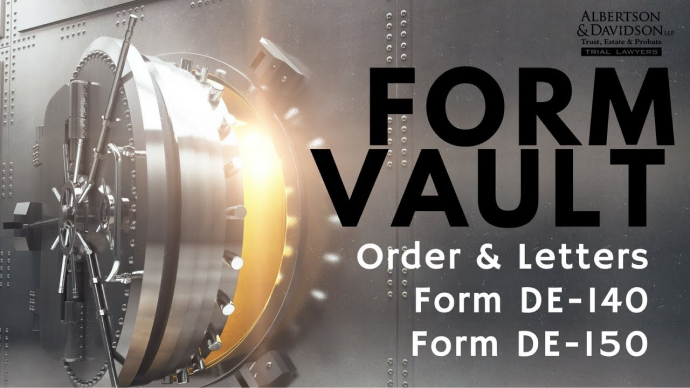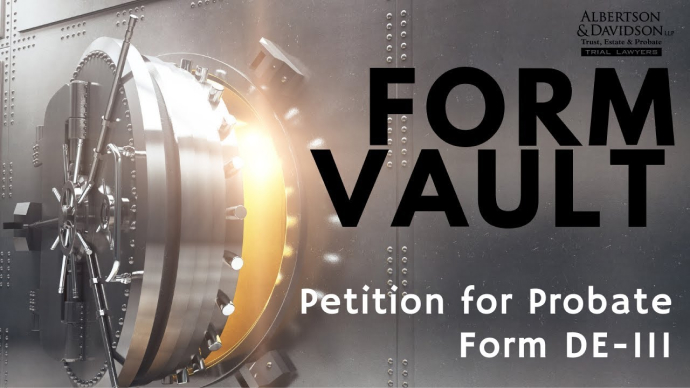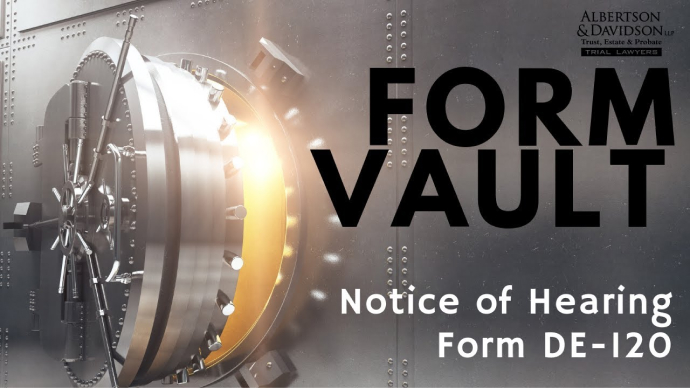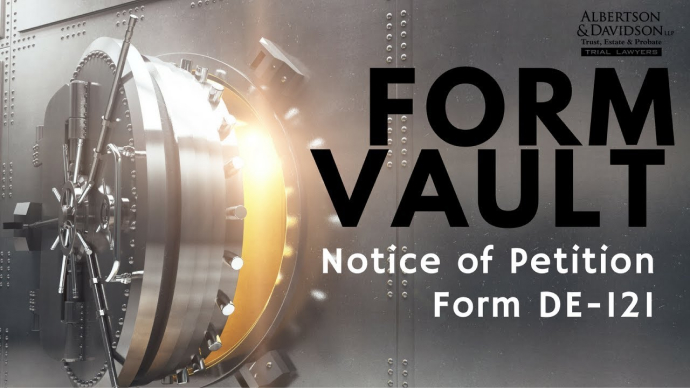Video Transcript
The following is an unedited, verbatim transcript of our video. It is not intended to be a stand-alone article.
Hi, this is Keith Davidson from Albertson and Davidson. In this video, we’re going over two forms, DE 140 which is the Order for Probate, and DE 150 which are the Letters, Testamentary, or Letters of Administration. Both of these forms are going to come at the end of your Petition for Probate once the court has a hearing on the petition and once the court grants the petition and allows the petition to move forward. But these forms typically should be prepared at the time you’re preparing your petition for probate. There’s some courts, some counties that require you to submit copies of the order and the letters at the front of your action. So when you go down and you file your petition for probate, they want to see the Orders and the Letters, and you will submit those to the court as well. You won’t file them with the court technically because Orders aren’t filed until they’re signed by the judge, and the judge isn’t going to sign your Order until your petition is granted after notice is giving and given and a proper hearing has had, but the courts, a lot of courts still want these forms submitted, so that they have them and they’re ready to go when the time comes. Some courts do not want you to submit the Order in Letters. So every court is a little different, but you should prepare them and have them ready to go because you’re going to need them eventually. Sooner or later, your petition will be granted.
What Do You Use DE-140 & DE-150 For?
So let’s go to Google and we’re going to type in judicial council forms and we’re going to go straight to the court’s website and we’ll just going to go to Probate, Decedent’s Estates, that’s where all of our probate forms are going to be found. And there’s two different forms that we’re dealing with, and I’ll explain what the difference is in a minute. So, there’s DE-140, the Order for Probate, and then there’s DE-150, the Letters. So let’s take a look at what these documents are. So, here’s the Order for Probate, form DE-140. So everytime the court takes an action, it does so by issuing an order. So you file a petition for probate and your petition is asking the court, will you please open probate, will a admit a Will to the probate and make sure that the Will’s valid so we can manage the estate under the terms of the Will if there is a Will, or if there isn’t a Will, if you’re doing an intestate estate, as it’s called, then you just open probate and allow us to administer this estate under the intestate laws under the Probate Code. That’s what you’re asking the court to do with the petition for probate. The Order is then the courts issuing it’s directive. So if the court says, “Yes, I’m going to grant this petition”, the judge says that, then you’re going to do it in a form of an Order. So you fill out the order because you’re the petitioning party, but the court will review it and sign it, and once the judge signs it, then it’s filed in your probate action send it becomes an order of the court. But the order does not allow the executor or administrator to actually go out and take possession of the estate assets, that’s where the Letters come in. So once the order is signed by the judge and filed, then the clerk of the court has to issue Letters, and Letters is a very old-fashioned term, and people get confused by this because they’ll go to try to get a decedent’s bank account and the bank will say, “well, you need Letters”, and then they’ll call up a lawyer and say “Can you write me a letter, I need a letter”, it’s not the type of letter, it’s not a written letter, this is something that issues from the court, and Letters, the way to think of these is that this is the authorization document that gives the personal representative the right to go out and to obtain control of all of the decedent’s assets so that they can go to the bank with this document called Letters and they can gain control of that money. They can use these Letters to be able to control real property and do a sale and close escrow, all because of the power that is issued when these Letters are signed by the clerk of the court. But Letters can’t issue until order is first entered, and so let’s start with the order.
So I filled out all my information at the top, we’ve seen this before, and I just realized I misspelled courthouse, we’ll put an e in there, and then we’re using the estate of Rachel Smith and this is Bob Smith bringing the petition. You’re going to put in your case number if you’re filling this order after the petition has been granted and then you’ll know your case number if you’re submitting it to the court at the time you’re filling your petition for probate, the you’ll just leave that blank. The Order is going to mirror the petition, so everything you’re going to ask for in the petition, your now going to mirror that in the Order. So this is an Order appointing either an executor, administrator with Will annexed or administrator. If you watched my video on the DE-111, petition for probate, I go into an explanation of what these different terms mean. So, whatever you did on the petition, you had to select one of these on the petition, you’re going to select the same thing on the Order. And then you’re going to select whether or not the court approved an order authorizing independent administration of the estate, either with full authority or limited authority. So if you’re submitting a petition where you asked for this then you should check it in the Order as well. If you’ve already had a hearing and the court has granted this, then obviously you will want to check these two boxes. And then you’re going to put in the date of the hearing, this is a past date when the hearing took place. If you’re submitting this Order at the time you file your petition for probate, so the hearing hasn’t happened yet, you’ll just leave this blank, but if the hearing has already happened and the court approved your order and granted it, then you’re going to put in the date that is in the past where the court granted your Orders. So on this date, at this time, in this department, you know, and whatever the judge in that department, they made the following Order, so the court finds number 1, that all notice is required by law have been given. That’s important, you have to give notice. Decedent died on, so whatever date decedent died on, you put that here, and a resident of the California County named above because we’re in Los Angeles County on this example and so that’s where you need to say that they were resident. Decedent died either intestate or testate, intestate means no Will, testate means a Will. And if it’s testate, then the Will was dated on whatever date it was dated, so let’s say it was February 1 of 2005, and you put in any codicils, codicils are just amendments. I was admitted to probate by minute order so the minute order is just a written document that the court puts out on the day of the hearing or the court granted your petition, and the court makes a note of every action it takes and that note is called a minute order. This is going to be an official order, so once you fill this out, it’ll replace the minute order.
Alright, so the court orders that, somebody in our case, Bob Smith, that’s our petitioner and the person who we want to have act as personal representative, so Bob Smith is appointed personal representative, and again it’s either going to be executor of the Will, administrator with Will annexed, administrator, go to my video on DE-111 petition for probate and you can see what those terms means. So in our example, Bob Smith is the executor. And Letters shall issue on qualification which means that you have to do certain things to get your Letters, with full authority if that’s what the court granted, with limited authority.
Bond
And then down number 5, either bond is not required or if the court did require a bond, then bond is fixed at a certain dollar amount. So let’s say the court said “Well, I want you to have a hundred and twenty thousand dollar bond”, then that’s what you put right there as part of the Order. They also have an option of putting something in a blocked account, that doesn’t typically happen, but if the court were to order some of the estate money in a blocked account, then you would indicate that right here with C. And D is the personal representative who is not authorized to take possession of money or the property without a specific court order. That, those are rare cases, but if the court were to order that, then you would check that.
Probate Referee
And then the court is going to give you your probate referee. A probate referee is just the person who’s going to appraise all the assets for you and you’re going to have to use that person to praise everything in the estate other than cash. So even if the estate has publicly traded securities, let’s say you have an estate that has a thousand shares of Apple stock, you can’t value that as a personal representative, the probate referee has to value that. The court is going to assign you a referee, and so the court will put in the name of the person right here. And then if there’s any attachment, so sometimes, the court will have some orders or some special instructions, if that’s the case, you would put them on an attachment. And if there are attachments, you have to put how many pages are attached, and you have to say that the signature of the judge will follow the last attachment. So the judge is supposed to sign at the very end of the order, and so that’s where the judge will sign. If there’s no attachments, then you’ll just leave that blank, and obviously the judge will sign here. You don’t have to sign anything on this. So you’ll print this form, you’ll save it, you’ll give it to the court, and once the judge signs right here, then it’ll be filed. And once it’s filed, you’ll have your order. Once you have your order, then you can go over to your Letters, and this is where the court clerk is going to issue you Letters that will give you authorization to do everything you need to do.
What Type of Letter Do You Need?
So again we’re dealing with the estate of Rachel Smith, we’ll put in our case number if we have it, and then we’re going to say the type of letters we want. We either want Letters Testamentary, Letters of Administration with Will Annexed, Letters of Administration, or Letters of Special Administration. And it just depends on whether or not we have a Will testamentary, means we have a Will and the person who is going to be given these letters is named in the Will to act as an executor or the person who has given these letters is not named in the Will but there is a Will but they’re still going to manage the Will even though they’re not named in there as the executor. And if there’s no Will, it’s just going to be Letters of Administration. So we’re going for Letters Testamentary, meaning there’s a Will and Bob Smith was mentioned in the Will. So now we’re going to say that the last Will of decedent named above having been proved, meaning that there’s an order right here for probate. Probate really just means proving the Will is accurate, that’s all probate means. And so that’s what this form is saying, is that the Will’s been proved, is being valid, and the court appoints Bob Smith as executor, here’s these terms again, so you’re going to know what these terms are. Or the court appoint somebody as administrator, all these terms, we’re doing testamentary so we’re always going to be on number one because Bob is an executor. And or if there’s a Will and it’s going to be administrative with Will annexed.
Two only applies if there’s no Will, so it’s an intestate estate or you’re doing a special administration.
Then down here, the personal rep is authorized under the independent administration of estates act with full authority. So these Letters are going to issue, and everybody who deals with this personal representative is going to know that they have these independent powers, so people have to know that.
Number 4, the personal rep is not authorized to take possession of money. That’s a rare case, but if that were the case, then that would have to be checked.
So you fill all of that out, and then that’s pretty much all that you do. Over here, we have the affirmation clause, so this is where you’re going to fill out if you’re an individual. I solemnly affirm that I will perform the duties of personal rep according to law. You’re not going to do public administrator, because unless you work for the county, you’re not a public administrator, and you’re probably not an institutional fiduciary, but if you are, you would fill that out. And so, you just put in the date, the place where you sign this, and you sign it. Down here, the clerk is going to issue these Letters. So the clerk of the court will sign it, they’ll put the seal of the court right here. A lot of times, people are going, like if you go to bank, they’re going to say “Well, we want to see an original of the Letters”, meaning that the seal that court uses is in red ink. So sometimes, you have to get multiple originals from the court that have the red ink because a lot of people don’t want copies, they don’t want to see black. A copy down here which would mean the seal would be in black ink when you make a copy of it, they want to see an original. But you can do that, you can go to the court, the court doesn’t call them originals, the court calls them certified copies. So the certified copies will have the red seal down here, they charge for that, it’s more money to get a certified copy but you’re going to have to have it, so it doesn’t hurt to start off with four, five, six certified copies from the court when you get your Letters.
So you can save this form, you can print it. Once you have your Letters issued by the court, now you’re good to go, you can go out, you can take possession of the bank accounts, the financial accounts, the stocks, the bonds, the real estate, and you can manage this estate.
So that’s our discussion of Form DE-140, Order for Probate, and Form DE-150, Letters, either Letters Testamentary or Letters of Administration, depending on your circumstances that you’re going to need in your Petition for Probate.




